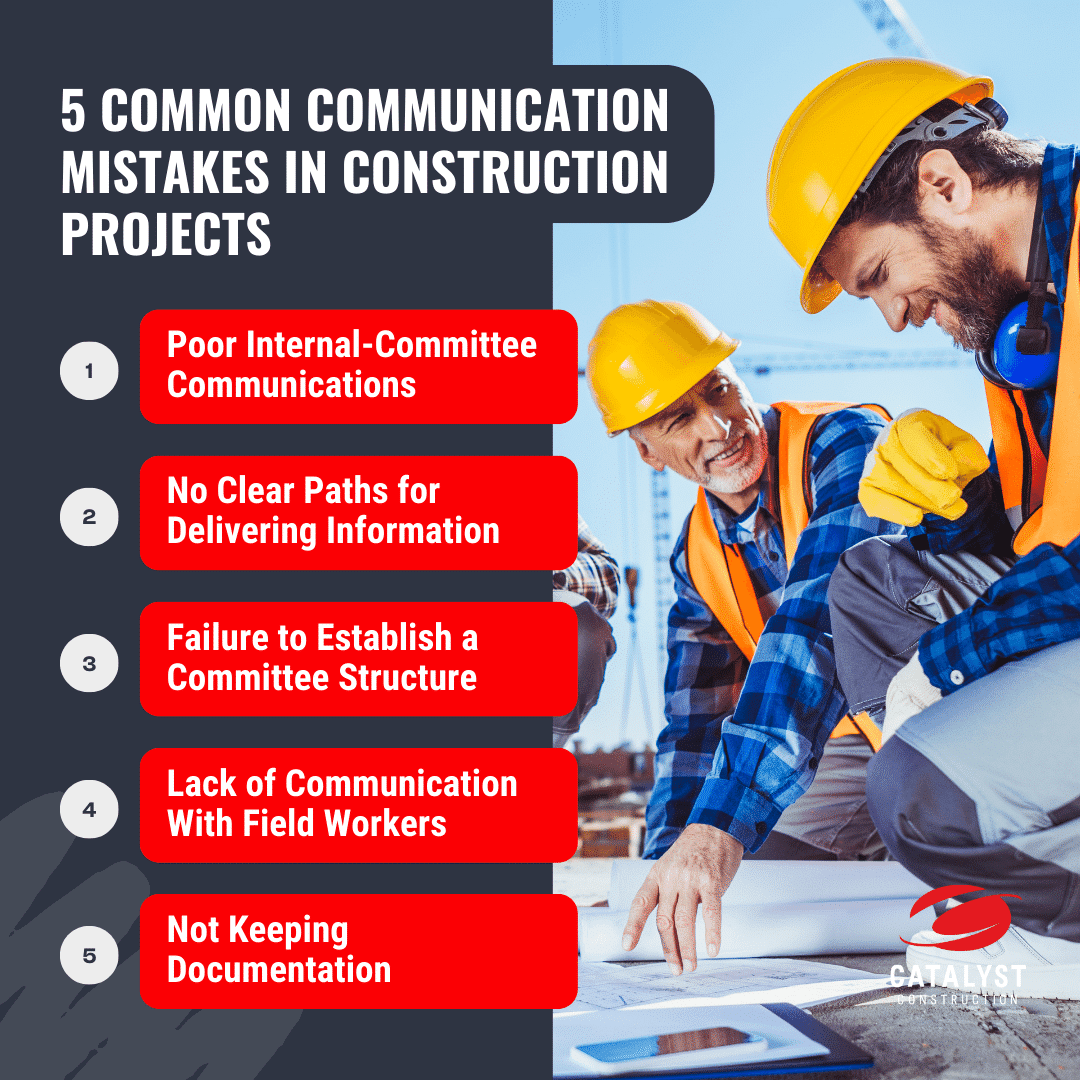Have you ever hit “send” on a text message without double-checking it? And has the “autocorrect” function ever failed you so miserably that what you sent completely confused the message?
Communication is as basic and essential to humanity as breathing. Unlike breathing, though, sending and receiving messages can get complicated.
When it does, progress of all kinds can grind to a halt, including construction projects.
Effective communication is the backbone of a well-executed construction project, from coordinating tasks and ensuring safety to managing timelines and budgets.
With over 17 years of experience and roughly 45 projects completed each year, we have seen our fair share of communication problems disrupt construction projects.
But it doesn’t have to be this way. If you understand and address these common mistakes, project managers, contractors, and stakeholders can enhance communication practices and improve project outcomes.
Join us as we delve into these common pitfalls and discover strategies for effective communication in the construction industry.
The Real Cost of Poor Communication in a Construction Project
Poor communications cost you. They cost you time and money, which can add up to a considerable sum over the lifetime of your project.
In addition to wasting money on extra labor costs like having to pay for more workers or buying more materials because something wasn’t specified correctly or communicated well enough by an employee, poor communications between team members also increase safety risks. Poor communication slows down production schedules, causing project delays and making it difficult for team members to work together efficiently.
Here are some examples of what poor communication costs:
- You lose time because something isn’t done when it should be or because your team could not communicate effectively and had to do something twice.
- You lose money because someone makes a mistake that could have been avoided if they knew the plan or because there’s confusion around who is responsible for doing what.
- Your team may be unable to do things right if they don’t understand how they’re supposed to do their jobs.
- Poor communication also leads to wasted projects as well as unhappy customers.
Without effective communication, keeping the project on schedule and within budget is impossible.
The planning stage ends with completing the final inspection process. Between these two points are many tasks that must be completed by contractors, subcontractors, suppliers, architects, and other professionals involved with your project.
You should always strive to improve communication between all parties involved in the construction project – from architects and contractors to owners and constituents. This will help ensure that everyone understands what they need from each other and that all parties know exactly how their contributions affect the project’s outcome.
Poor communication costs you time and money, which can add up to a considerable sum over the lifetime of your project.
It also threatens your reputation.
Most construction projects don’t have the budget to waste money on extra labor costs like paying more workers or buying more materials.
But this is common when something isn’t specified correctly or communicated well enough. Poor communication between team members also increases safety risks.
It slows production schedules, causing project delays and making it difficult for team members to work together efficiently.
Poor communication comes at a high cost:
- Task confusion and redundancy cost time
- A lack of clarity costs money
- Unclear job descriptions and boundaries cost morale
- Project delays cost clients’ confidence
5 Common Communication Mistakes in Construction Projects
The construction industry is fast-paced, dynamic and requires effective communication. There are dozens of people involved. Everyone must work toward a common goal.
If your team has difficulty communicating, it can cause delays, increase costs and tension. Here are some common ways that construction projects fail due to poor communication.
1. Poor Internal-Committee Communications
Poor internal-committee communication can lead to misunderstandings, delays, and cost overruns.
It creates ambiguity regarding responsibilities and communication channels within the project, resulting in conflicting interpretations and directions. This leads to inefficiencies, mistakes, and delays in task completion.
Inadequate communication hinders timely access to information and updates, disrupting the project timeline. It can cause cost overruns due to missed opportunities for issue resolution and miscommunication about budget constraints.
Furthermore, poor communication impedes coordination among committee members, resulting in redundant work, wasted resources, and frustrated team members.
No one wants to have their valuable time and effort squandered by poor communication.
Establishing clear communication protocols, defining roles, and promoting a culture of open dialogue can address these challenges.
2. Not Having Clear Paths for Delivering Information
You must be clear on who should communicate what to whom at any moment. To communicate effectively:
- Both parties must understand each other
- There needs to be a clear path for information flow
- Communication methods should match up with who is talking with whom (i.e., email vs. face-to-face).
- You must have the right tools to facilitate communication among all parties. Establishing precise communication methods (software/ways) is critical for productivity.
By establishing clear paths for delivering information, ensuring mutual understanding, and utilizing appropriate communication methods, construction projects can minimize communication-related challenges and enhance productivity and collaboration among all stakeholders.
3. Failure to Establish a Committee Structure
With multiple stakeholders involved in numerous aspects of the project, you need to be clear on these basic questions:
- Who
- What
- Where
- When
- Why
- How
What committee needs which information? When do they need it? How will they receive it? Who is responsible for ensuring communication is sent and received to each stakeholder?
If you don’t have a clear strategy before starting work on your next construction project, you will inevitably run into problems.
A good communication strategy should be created at the beginning of any project so everyone knows what to do and when to do it.
4. Lack of Communication With Field Workers
You can’t rely on emails and texts. Construction workers must be kept informed of all changes, even minor ones.
Communication is not just about sending messages; it’s about ensuring you understand what your team is trying to achieve, why they want certain things done differently in the field, and how you can help them get there.
A communication plan will specify exactly where each part fits into its context so there aren’t any ambiguities about what needs to be done next (or why).
It should also highlight areas where changes might occur so people don’t get caught off guard when something unexpected happens instead of having time to prepare themselves mentally and physically (e.,g., getting their tools ready).
5. Not Keeping Documentation
Documenting communications is vital for any building project but especially important for those involving multiple parties.
A written communication track can help keep the project moving forward. It will also ensure everyone understands what is expected at each project stage.
A comprehensive communication track should include the following items:
- What needs to be completed by when (for example, “Project Manager: Complete all drawings by May 15th”)
- Requirements for each phase (for example, “Designer must attend weekly walk-throughs with client”)
Who is responsible for doing what (for example, “Architect will provide construction plans to Project Manager”)
Quick Tips to Improve Communications Throughout Your Building Project
Thorough communication is a construction project in and of itself! It costs on the front end, but saves time in the long run. Here are a few quick and easy communication tips you can implement today!
- Require Committee and Executive Support: You cannot allow executives to avoid responsibility for their decisions by having committee members make the final call. This exacerbates communication breakdowns and usually results in an executive backlash that leads to delays, revisions, and cost overruns.
- Establish Clear Processes: Having processes in place can also help improve communication throughout your company by keeping things consistent and on track across multiple projects. You don’t need detailed documentation or extra training when starting new ones.
- Practice Good Listening: Even if something doesn’t make sense immediately, listening carefully before asking questions or correcting someone else’s work (or yours) is crucial. Something small could make all the difference in getting things done quickly without delay or confusion.
- Communicate With Every Stakeholder: Ensure every stakeholder is aware of what’s happening in the project and has access to essential documents, such as meeting minutes and RFPs. This can be done through any mode of communication – whatever suits your organization best.
- Communicate Goals Upfront: Everyone on the team must be aware of who else has been involved in developing the building plan (architects and engineers), who else needs to be involved (local government officials), and what resources they’ll need to access to (construction documents), etc., as soon as possible so they can start preparing themselves for their responsibilities during construction.
Create a Culture of Communication with Catalyst Construction
Effective communication is crucial for successful construction projects, as poor communication can lead to costly delays, errors, and safety risks.
Construction projects can enhance productivity and collaboration by incorporating these practices and actively listening to all stakeholders.
At Catalyst Construction, we understand the importance of effective communication in construction projects. Our team is committed to promoting clear and transparent communication channels to ensure project success.
Contact us today to discuss your construction needs and learn how our expertise and focus on communication can benefit your next project.







